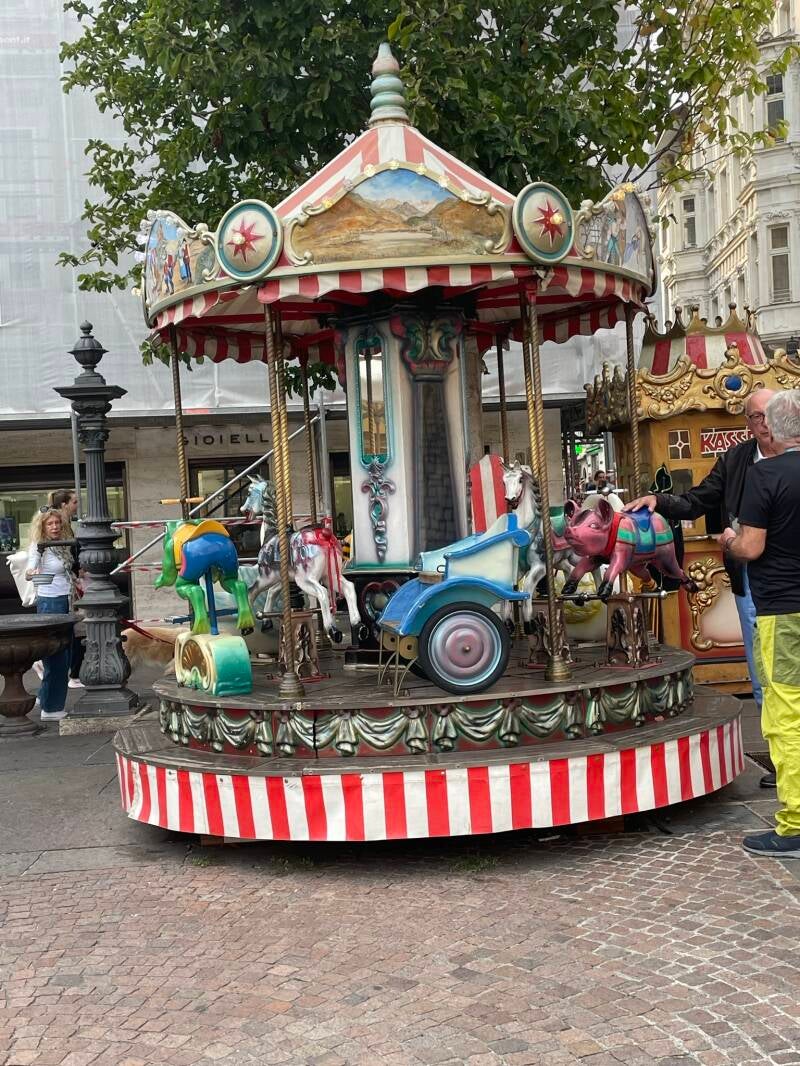Day 3 & 4 - Dolomites and the Iceman
Verona

Both Daniella and our local guides were very helpful in making suggestions and recommendations on additional things we might want to see as we went along or places to eat.
Verona, Italy, is known for its vibrant street markets where locals and visitors alike can browse a variety of goods. Italian markets offer a glimpse into the local culture, cuisine, and craftsmanship of the people who live here. Whether you're searching for fresh produce, unique souvenirs, or hidden treasures, Verona's street markets had something for everyone to enjoy.

A tour "train" down in the market area.
On our way to the Dolomites and the city of Bolzano we had a stop in Verona where we had a walking tour of the city by Valeria, a local guide. Her personal take on the history of Verona made our visit even more special and we left with a solid knowledge of our time there.

As I mentioned before, one of the things we loved about our Rick Steve's tour was the amount of free time that was available to us each day. We never felt like we were being pushed or being led around by the nose. On the contrary, we had a perfect combination of group events and tours and time where we could wander back to an area of interest to spend more time exploring. We had plenty of time to wander through town, get lunch, visit churches and check out the street markets.

Street market in Verona




The fellow running this little cafe had very good English and a great sense of humor!

The city's narrow cobblestone streets, elegant squares, and ancient monuments provided a charming backdrop for exploration.


One of Verona's most iconic landmarks, the Arena di Verona is a well-preserved Roman amphitheater that dates back to the 1st century AD. Today, it hosts opera performances, concerts, and other cultural events, drawing visitors from around the world.
Bolzano
We arrived in Bolzano before dinner. Our hotel was situated along Piazza Walther/Waltherplatz, a large town square filled with restaurants and lots of outdoor seating. People watching at its best! Bolzano is situated at the crossroads of Italian and German-speaking regions, resulting in a unique blend of cultures and languages. You'll find street signs and storefronts in both Italian and German, reflecting the city's dual heritage.


Bolzano sits high in the Dolomites with incredible views of hillside vineyards and pastures of cows and horses. The street markets were full of fresh fruits and vegetables, meats, cheeses, oils, etc. I could have spent hours here!







There is a strong German influence in Bolzano. We had both our group meal, our hike into the Alps and the next night's dinner at German restaurants exploring Tirolean cuisine at its finest.
For our full day in Bolzano most of the group opted to go hiking up in the Alps, about a 30-minute drive. John and I and one other fellow group member, Carrie, decided to take the cable car up to Oberbozen and hike. Heights are not my strength, but determination and the beauty of the countryside got me up the mountain! It was a fabulous day with a few clouds and the perfect temperature for hiking.
Map in hand we decided to take the train to Klobenstein/Collalbo to hike to a small church and see the "earth pyramids".

The scenery, the homes and the countryside were just like you would imagine in the Sound of Music. As we walked past farms and pastures filled with cows and horses, you couldn't help but see Julie Andrews singing and twirling in the fields.
The scenery was incredible and the walk a bit challenging, but doable. On the way to the church we had for our destination, we found a small German restaurant where the waitresses were dressed in a dirndl, which is the traditional dress worn in the Alps. This tiny restaurant was sitting next to a small church with fields and mountains as far as you could see in every direction. This was no tourist spot, just a couple dozen locals enjoying lunch together. The menu was simple, but our food was delicious. John and I both had bacon dumplings in a beef broth and a beer (we are in the German part of the Italian Alps after all).




These cows were pretending we were not there, but they were definitely keeping an eye on us as we walked by! All the cows were wearing large cowbells just like you would expect in the Alps!

Our token mountain goat!
The Earth Pyramids were formed by the erosive action of water and wind on glacial moraine deposits left behind during the last Ice Age. Over thousands of years, the softer layers of clay and sandstone eroded more quickly than the harder layers of rock above, resulting in the formation of tall, column-like spires topped with large boulders. The Earth Pyramids vary in height, with some reaching up to 30 meters (approximately 100 feet) tall. The distinctive spires are topped with large, mushroom-shaped boulders that protect the softer layers of clay and sandstone beneath. They are very impressive to see in person.
The following morning, on our way to Venice, we went to The South Tirol Museum of Archaeology to study the prehistory of the region and see the preserved body of 5,300-year-old Otzi the Iceman. Ötzi was discovered in the nearby Ötztal Alps and is one of the oldest and most significant archaeological finds in the world. We were given headsets to listen to as we wandered, at our own speed, through the museum. It was an interesting and a one of a kind of museum.















Create Your Own Website With Webador